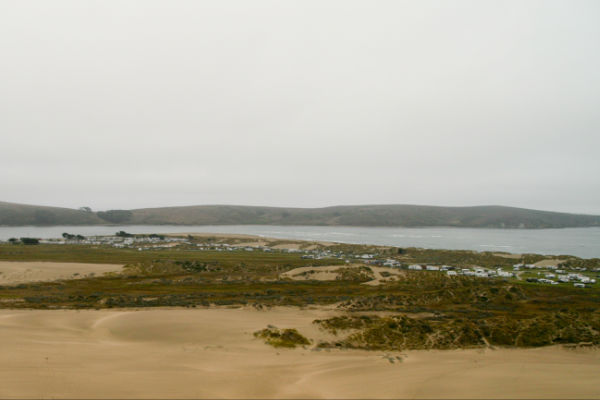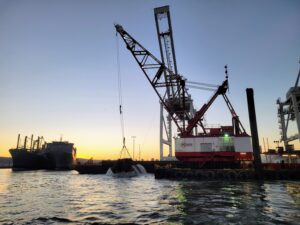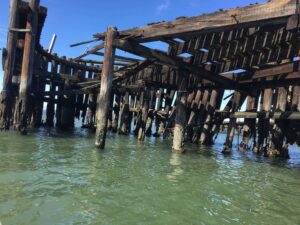Jul 15, 2011, UPDATE: At its meeting on July 13, the Coastal Commission approved a compromise plan on the future of Lawson’s Landing. Read the Marin Independent Journal’s summary of the meeting. The Environmental Action Coalition of West Marin, a key critic of past plans, declared the compromise a victory. Download their PDF press release.
It’s a sunny October weekend, one of the last before the season turns, and the largest private campground along the California coast is packed. Families tuck in around campfires and Weber grills, shielded from the breeze by semicircles of shiny RVs and Ford F-150s. Kids pedal a gravel road down to the dock, passing rows of timeworn trailers, many rooted since the 1960s. A couple of old-timers sip coffee and reminisce outside the bait shop, gazing out at a bay full of rock crab, halibut, and oyster ripe for the pluck.
For nearly five decades, the campground at Lawson’s Landing has existed in a sort of legal limbo, never acquiring the necessary permits to make camping legitimate. Now, after a half-century of unauthorized expansion, the campground finally looks set to resolve its long-standing rift with the law. The California Coastal Commission meets July 13 in San Rafael to decide the campground’s future.
Visitors, most of whom come from the suburbs of the Sacramento Valley, say Lawson’s Landing is one of the last RV-friendly campgrounds along the central coast, and about the only place where you can drive, camp, stomp, and build a fire pretty much wherever you like.
“I first heard about it as a kind of Wild West scene with no permits,” says Catherine Caufield, a conservationist who, for the past twelve years, has led a hard-driven campaign to protect the landscape and underlying ecosystem of the property.
- The high interior dunes provide sweeping views of the campground and Point Reyes peninsula just across Tomales Bay. Photo by Lucía DiPoi.
For the environmental community, stakes are high as well. Lawson’s Landing holds some of the last native dune habitat along a California coastline once rolling in sand. Much of the campground also lies adjacent to sensitive wetlands – an unprotected sanctuary for wildlife and native plants. Over the past several decades, the proximity of such valued habitat to a bustling campground has turned Lawson’s Landing into the site of a pitched battle over land use: the campers versus the endangered frogs and other specialized inhabitants that cling, nest, and burrow there. Bay Nature covered those habitats in detail in our 2008 feature Shifting Sands.
Critics, who have long charged the campground with leaking sewage into Tomales Bay, argue that camping in wetland areas violates county law. Also of concern are the 233 individually owned, permanent trailers on the site. Then there is the sheer volume of campers. On peak summer weekends, the campground packs in as many as 2,000 people, enough to dwarf every other town on the Marin County coast. Worried that fully resolving even a couple of these issues would put them out of business, the Lawsons and their supporters have held firm, resisting demands the owners deem exorbitant.
“We’re not small or hiding,” says Willy Vogler, one of the Lawson owners. “We’ve been here since before the Coastal Commission.”
Since its inception in 1972, the Coastal Commission has regularly sought to limit private property owners who seek to develop and use their land at the “expense of community values,” in the words of its director, Peter Douglas. But Lawson’s Landing, itself a fairly strong community despite the coming and going of campers, presents a unique case: How does the commission respond when an issue pits its two main concerns – preserving the environment and ensuring public access to the coast–against each other?
***
As you drive along Highway 1, it’s apparent that Marin County has long embraced both open natural landscapes and working farmland. Most of Lawson’s Landing, open to cattle and sheep ranching, seems to fit well in that setting. Set in the northwestern reaches of the county, just south of Dillon Beach, on Tomales Bay, the property covers 950 acres. The Lawson family originally bought the land in 1929 for ranching, but trailer homes began arriving in the 1950s and a campground slowly developed. Today, the Lawsons continue to operate a ranch on much of the land, with 50 head of cattle driven down from the older vegetated dune fields above the campground each autumn to graze the salt-grass flats and amble among the campers.
- Mike Lawson (left) and his cousin Willy Vogler grew up on the property and have owned and operated the campground since 2006, when Vogler’s grandparents retired. Photo by Garrett McAuliffe.
From the beginning, the campground and its attendant facilities were never fully authorized by any government entity. Over the past 30 years, nearly a dozen permitting plans were submitted and rejected, with regular requests for further environmental studies from the government, and each side repeatedly accusing the other of dragging its feet. At one point, the Lawsons withdrew their application completely, explaining later that they had become “disillusioned with the delays from the County and the costs of one expensive study after another with no end in sight.” Meanwhile, unpermitted development continued, and the campground at Lawson’s Landing swelled, setting off alarms above the county’s jurisdiction. By 1991, two state agencies had sent ultimatums that camping would have to cease if no agreement could be reached. But county officials came to the Lawsons’ defense, encouraging the state to wait while local permits were sorted out. With the county’s tacit approval, the state eventually began issuing temporary operating permits, allowing for 1,000 campsites and 233 permanent trailers. “The county has been very fair to us,” Vogler says.
In 2006, the state intervened once more. This time the Coastal Commission filed an enforcement order, formally charging the Lawsons with operating illegally. “We were treated like misbehaving children,” Vogler says, referring to the family’s first meeting with commission staff. “We thought we were done.” Under pressure, the Lawsons agreed to cease further development until permits had been granted. Amid increasing concerns they’d be driven out of business, the owners gathered thousands of signatures from supporters to “Save Lawson’s Landing.”
“Maybe there’s a reason why the Lawsons are in the position they’re in,” says Ruby Pap, the Coastal Commission supervisor currently in charge of the Lawson file. “They spent a lot of money trying to resist permits – with lobbyists, lawyers, planners. I mean this has been going on for 30 years.”
Despite the drawn-out financial strain of defending their campground, the owners insist the money was well spent. “We hired lobbyists,” Vogler says, “to keep from getting crushed like a bug.”
The county passed a negotiated master plan in 2008. Soon after, the agreement fell apart. Conservation groups accused the county of skirting its own laws. The permanent trailer owners, upset about an imposed 90-day occupancy limit, sued and won the right to remain year-round.
Two years ago, the trailer owners, along with a handful of environmental organizations, filed an appeal with the Coastal Commission, in the hope that they could settle the matter once and for all.
***
- The Lawson’s Landing bait shop, a converted barn, is among the top sellers of fishing licenses in the state. Photo by Garrett McAuliffe.
Just past a rack of packaged beef jerky, an open door inside the Lawson’s Landing bait shop leads to the main office. The owners, Mike Lawson and Willy Vogler, are seated at their desks, surrounded by stacks of environmental impact reports and revised master plans, looking like two ranchers who’ve lost their herd. They’ve just finished another meeting with their $100-per-hour planning analyst. During the past five years, they’ve hired seven different consulting firms, including biologists, engineers, lawyers, and lobbyists, at a total cost of $2.5 million. “I would rather have spent the money on new bathrooms,” Vogler says. “But our message is clearer when smarter people say it.”
He and his cousin Mike took over in 2006, after his grandparents stepped down. Slightly long-jawed, with a hint of bristle coarsening a lean, weathered face, Vogler is the self-proclaimed office guy. “But I turn wrenches and help keep things running too,” he adds. When discussing the turgid legalities of permitting and jurisdiction, he tends to wince. Rarely and reluctantly expressive and, like most around the property, unpracticed at bureaucratic euphemism, he perks up when talk turns to Catherine Caufield, the former executive director of the Environmental Action Committee of West Marin, who continues to spearhead the conservationist cause against the Lawsons. “I’m tired of hearing her cry wolf,” Vogler begins. “She says, ‘The Lawsons are destroying the environment. There’s sewage running across the roads.’ We’d do well to have someone that passionate.”
The owners are quick to point out no signs of pollution have ever definitively been shown. Vogler mentions the water assessment tests the county conducts every two weeks. “We fail maybe once a year. Inverness, where Catherine lives, fails all the time.”
But wind and currents constantly stir the water around Lawson’s Landing, making it difficult to assess, according to Blair Allen, an engineer at the California Regional Water Quality Control Board. The state agency pressured the Lawsons in the past, but staff cuts during the last ten years have limited its reach. “Those old relics needed to be replaced long ago,” Allen says of the cesspits dug mostly by teenagers on summer break in the campground’s early days. “If we had more resources to do something, we definitely would.” The owners acknowledge the need for a new wastewater system. That has been the spine of their county plans since the late 1970s.
Caufield has also raised the issue of dune loss. For 35 years the Lawsons trucked sand from the dunes to golf courses and nearby ranches, for use as bedding in cattle barns. Only recently, they say, did it become apparent the interior dunes were not being replenished by foredunes closer to the shore. Environmental reviews of the property show that the interior dunes have already been reduced by more than a third during the last 50 years. In 2006, the owners decided to stop removing sand. “We like the dunes too,” says Vogler. “It’s part of the attraction. Selling them off for a one-time profit is not a good idea.”
Caufield says she considers the owners reasonable and genuinely worried about being able to keep operating. But, she adds, it’s a problem if they continue to regard campers as their extended family. Both she and staff at the Coastal Commission dispute the Lawsons’ argument that they would be forced to close if the campground size were reduced further and the permanent trailers removed.
Caufield says she would only like to see them subject to the same rules as everyone else. The Coastal Act, she argues, favors low-intensity access, not a carnival of RVs.
But there’s a cultural divide here that runs pretty deep. Consider Tim Woerner, who has lived in a permanent trailer on the property for nearly 40 years. He bemoans what’s happened to Tom’s Point, a chunk of rugged rock and wind-bent oak trees that juts out into Tomales Bay two miles south of the campground. Not long ago, the land was purchased by a local conservation group, Audubon Canyon Ranch. “It’s beautiful. And now it’s preserved,” Woerner says with good-natured exasperation. “So no one can go there except a few rich birdwatchers.” Caufield and the handful of environmentalists directly involved in lobbying for the protection of Lawson’s Landing reject the social class critique that’s often leveled against them, arguing that the issue is not birdwatching but the well-being of birds. “We speak for the critters and wetlands,” Caufield says.
However socioeconomic factors figure into the Lawson’s Landing conflict, few dispute that some level of human activity is acceptable, even desirable, and inevitable. But widespread agreement about where to draw the line is difficult, if not impossible, to achieve.
***
Depending on the season, Jenny Woodward spends a few afternoons each week wandering the beach and talking to visitors. She’s in a unique position since she grew up at the Landing and recently moved back because, as she says, “it’s a great place to raise a family.” She now serves as an on-site educator, part of an outreach program funded through the U.S. Fish and Wildlife Service’s Partners for Fish and Wildlife Program, to teach beachgoers about western snowy plovers, a small threatened shorebird that rests along the beaches of western Marin during its annual winter migration. “I tell people to give the birds a wide berth,” Woodward says. “It’s like a perfect storm of threats for them out here – people walking the beach, dogs off leash, and kites.” (Kites mimic the circling shadows of plover predators, falcons and hawks.)
Kate Symonds, a biologist with the U.S. Fish and Wildlife Service, partnered with Lawson’s Landing on the program, and is impressed by how tidy the back dunes look today, despite decades of high-volume camping. “I would think there’d be more plastic,” she says. “The back dunes are downwind, but there’s not a lot of trash there.”
The relatively untrammeled condition of the place helps explain why people are so interested in it today. A $1 million federal grant is in place to protect 50 acres of coastal dunes on the property, part of an overall effort by federal and state agencies and local environmental organizations to turn 400 acres of the land into a conservation area, while allowing the popular campground to continue operating.
Meanwhile, residents of the Landing continue to enjoy the place as they always have. On a warm Saturday, camper Rachel Moore spends her morning shoveling dirt to fill holes her dogs have dug in the grass meadow during the night. She praises the freedom and space afforded campers here compared with most state parks. “We like to have fun at night, without flashlight patrols coming to tell us to quiet down,” she says.
.jpg)
- Trailer owners, many of whom have been coming here for decades, gather for a potluck dinner. Photo by Lucía DiPoi.
Across from her site, just over a shallow brush of dune, a different scene unfolds: a 13-year-old boy and his father finish loading crab pots into the back of their truck, then start to toss a football. A minute later, the son charges into the dune’s loose white sand in pursuit of a wobbly spiral, crashing through a hummock of beach grass and coyote brush, before trampling a small patch of woolly-headed spineflower, one of 14 species in the area listed as threatened or of special concern by the government.
Vogler speaks of the American way of life, how it has long been dominated by a utilitarian relationship to the natural environment. “By having people come stay here we hoped our business could be less extractive of natural resources,” he says.
And it is less extractive than sand mining, but when the freedom of campers to do as they please is the primary value, environmental protection becomes mostly a matter of individual responsibility. This is precisely why the Coastal Commission was created. “Many of them don’t internalize or actually appreciate the awesome beauty of nature in its raw state,” says Douglas. “They don’t equate the two at all. It’s a different type of person who goes to Lawson’s than goes to Point Reyes.”
While some are less attuned to the ecological integrity that makes Lawson’s Landing a unique environment, everyone involved values the landscape, and certainly most hope that 100 years from now all of it will still be intact – the mobile dunes and snowy plovers resting on the beach, the wetlands, the silverspot butterflies sipping nectar from native vegetation. “Some people say they should be congratulated because it has lasted this long,” Caufield says. “But it remains an ecosystem under stress.”
Assigning value to other organisms and the ecosystems they depend upon for survival is a tricky business, especially for a species that doesn’t always share well with others. The final task has been left to the Coastal Commission, which will hear the appeal this month. “There is no other place like Lawson’s. It’s a unique situation,” Douglas says. “Our mandate is to protect a use like that, and promote it.”
A new proposal, paying the Lawsons to protect a large portion of the property, may be the most promising solution so far. “That means it’s still my land,” Vogler says. “But if something crops up and is killing the frogs, we have to do our best to get rid of it.” The Natural Resources Conservation Service has put forward a plan to set aside over half of the property as a habitat conservation easement, and it seems highly likely that it will be adopted.
Meanwhile, sometime this summer, the Lawsons hope to reach a final agreement that will allow their campground business to survive. Environmental groups will continue to lobby hard, battling to safeguard the dunes and its inhabitants, according to the provisions of the Coastal Act. And so will the Lawsons. “If the commission decides conservation is more important than access, then they’re making it up,” Mike Lawson says. “They’re going against the Coastal Act.” His cousin Vogler adds a last conciliatory note. “I think it will be a good compromise,” he says, “in that everyone walks away unhappy.”
Read more about the dune ecology at Lawson’s Landing in our 2008 feature Shifting Sands, by Jules Evens.
Details on the Hearing
The Coastal Commission appeal will take place Wednesday, July 13, at the Marin County Board of Supervisors Chambers in San Rafael. More info: coastal.ca.gov/mtgcurr.html. Commission staff will also lead a public field trip to Lawson’s Landing at 2 p.m. on Tuesday, July 12, starting from the campground’s main entrance. For more information, call the North Central District office at (415)904-5260.

.jpg)




